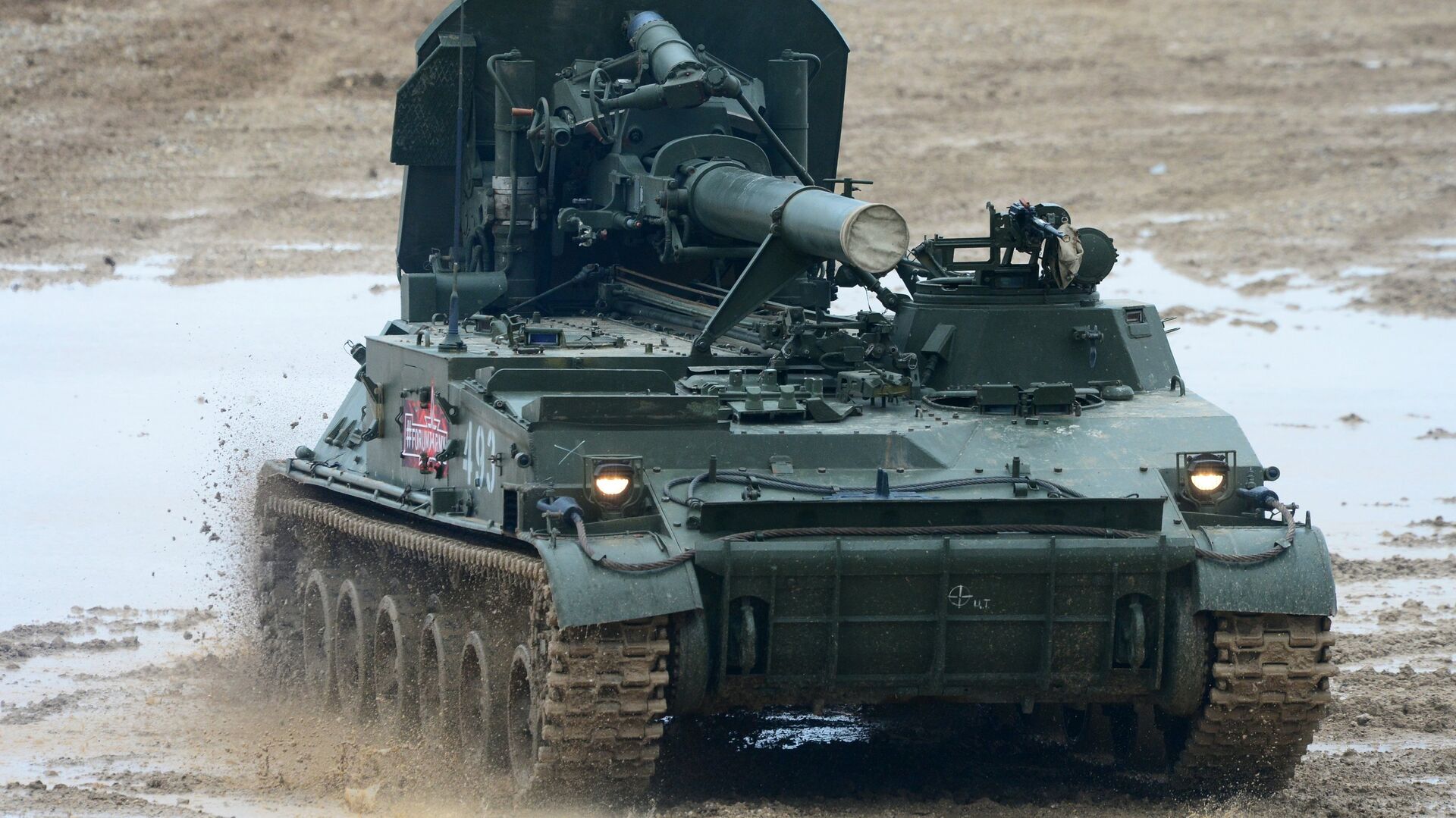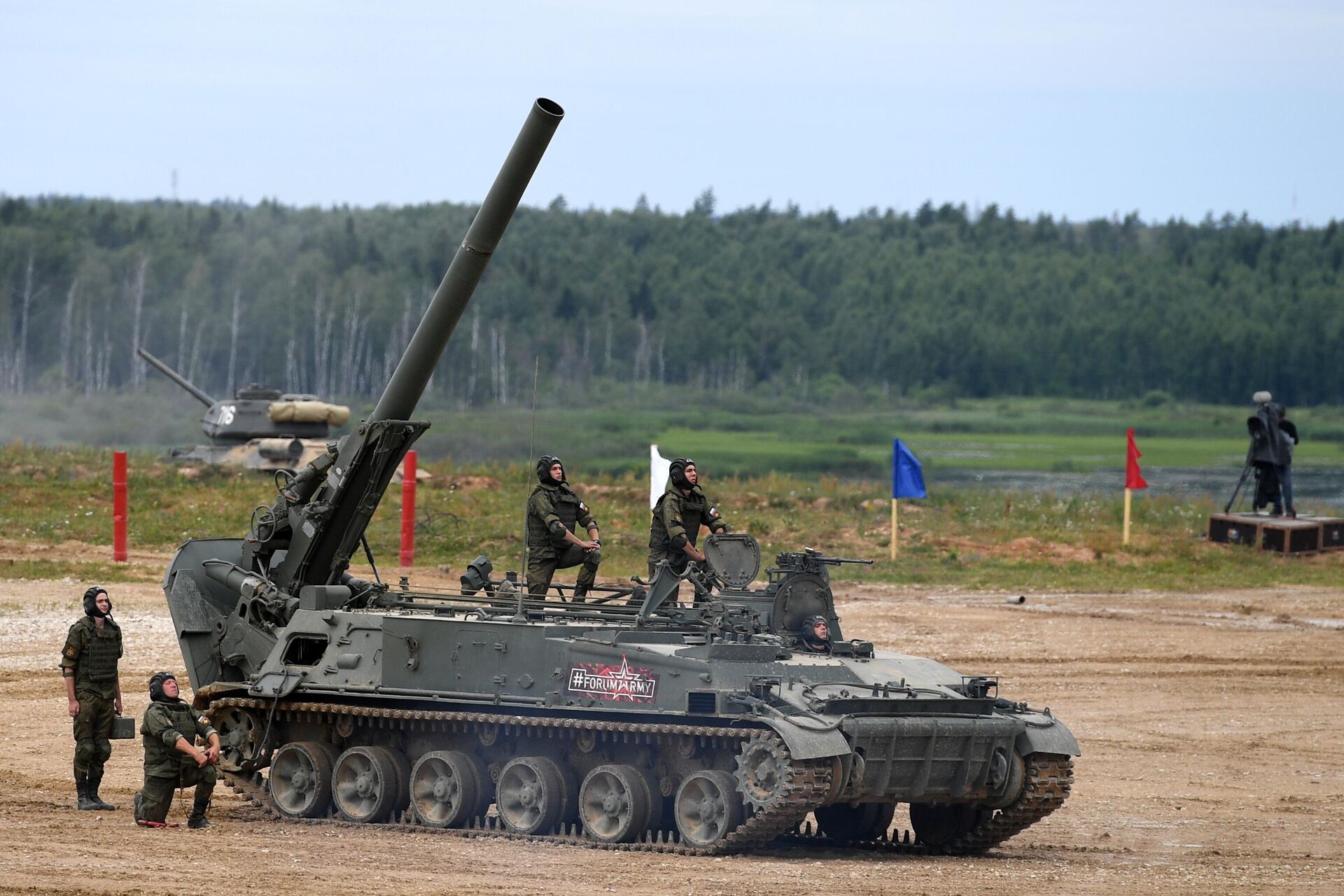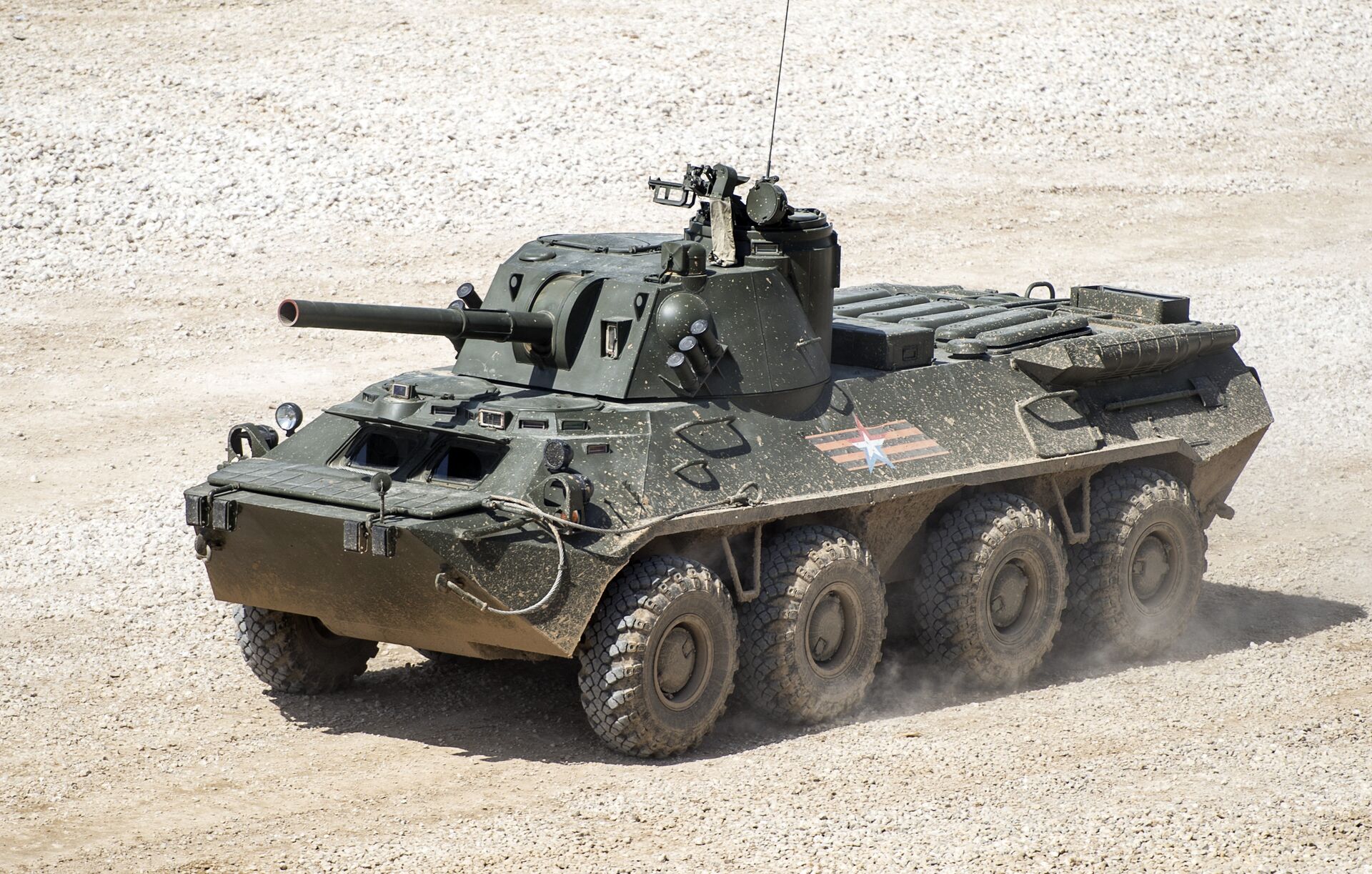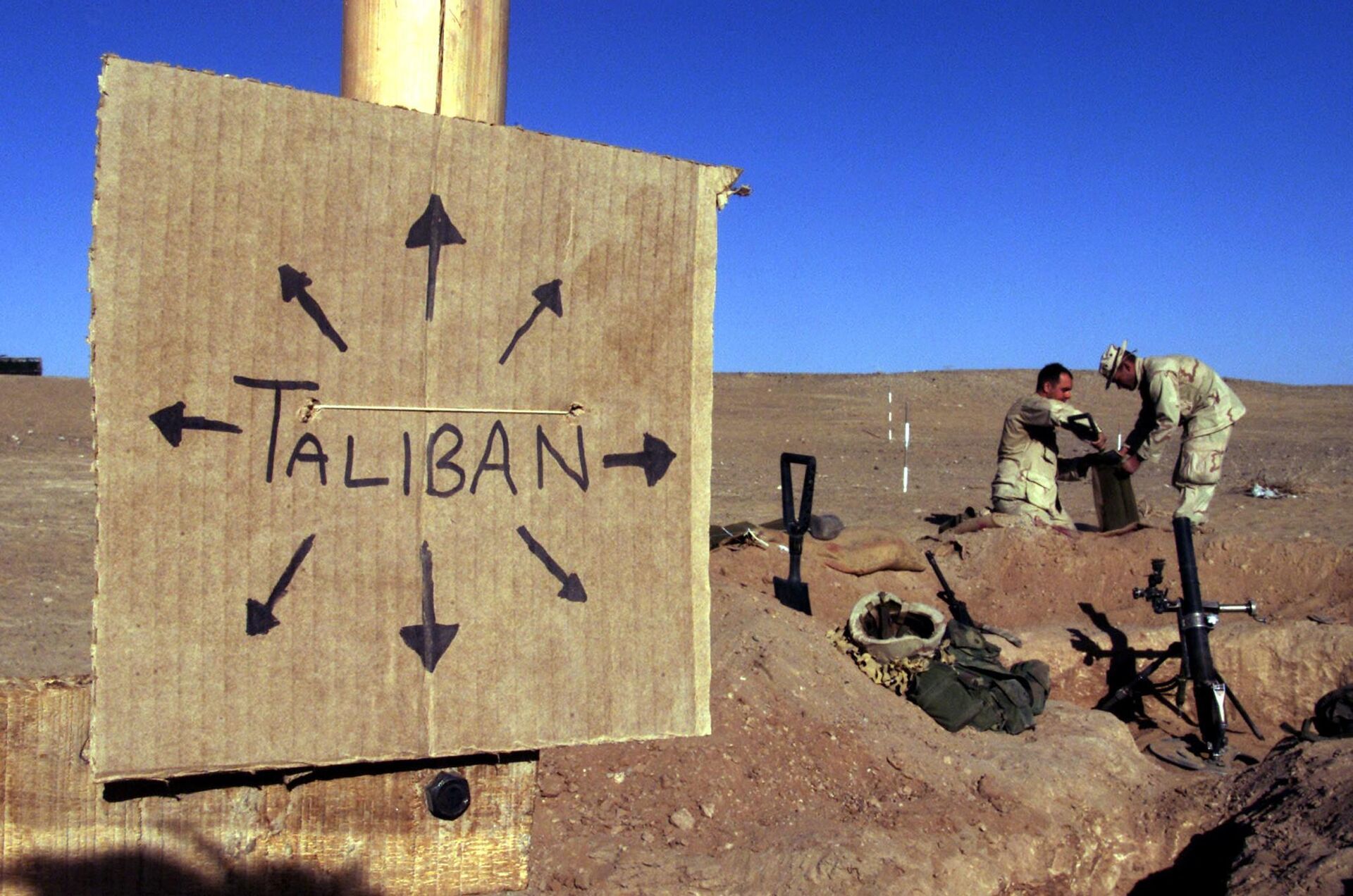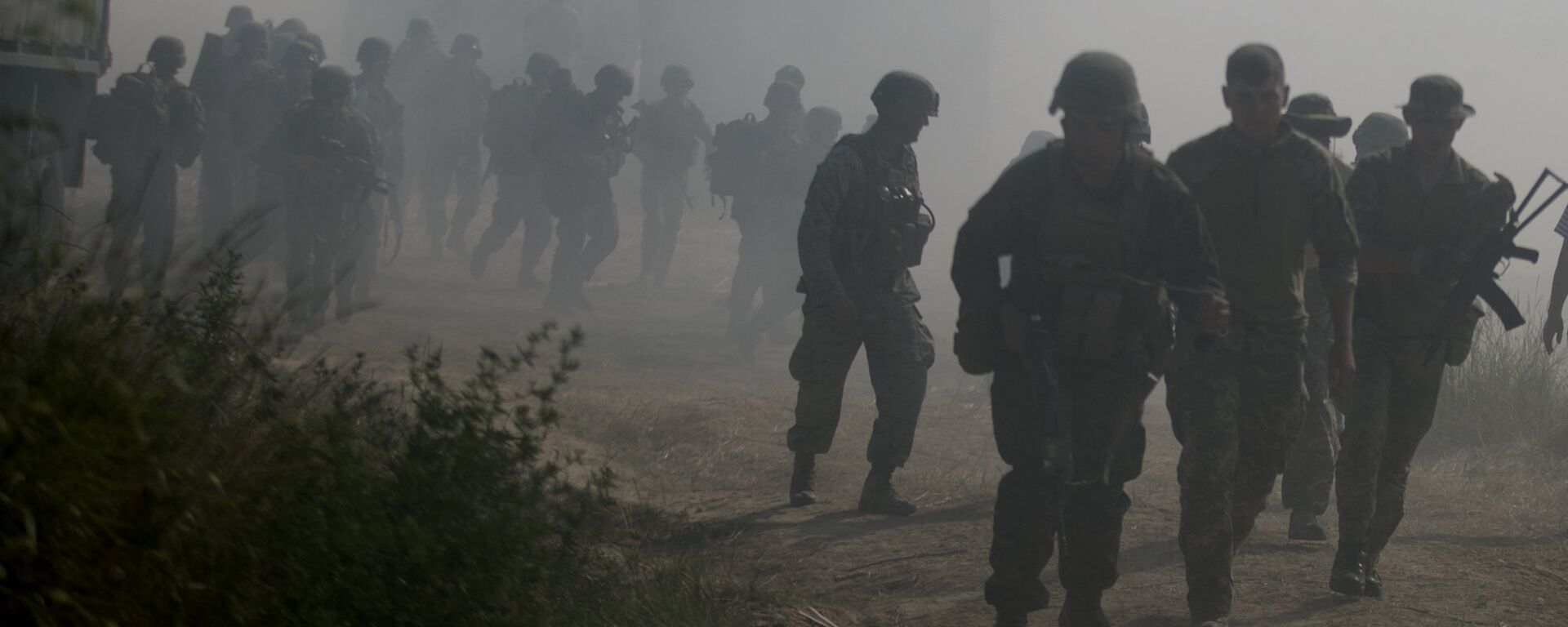https://sputnikglobe.com/20230113/what-is-the-2s4-tyulpan-supermortar-and-how-many-does-russia-have-1106286506.html
What is the 2S4 Tyulpan Supermortar and How Many Does Russia Have?
What is the 2S4 Tyulpan Supermortar and How Many Does Russia Have?
Sputnik International
Russia has deployed a range of heavy artillery systems in the Donbass against heavily fortified Ukrainian positions, including the 2S4 Tyulpan (lit. ‘Tulip’) self-propelled mortar. What makes them so deadly? Sputnik takes a look.
2023-01-13T12:50+0000
2023-01-13T12:50+0000
2023-01-13T13:24+0000
military
mortar
mortar fire
mortar shell
mortar system
artillery
artillery fire
artillery shell
artillery strikes
howitzer
https://cdn1.img.sputnikglobe.com/img/105746/55/1057465535_0:159:3076:1889_1920x0_80_0_0_669e4a331d49bacf977099e015e97a60.jpg
The Russian military released footage of an 2S4 Tylupan heavy mortar system in action last week, showing it pounding fortified Ukrainian positions with the assistance of a reconnaissance drone.What’s the Difference Between Mortars and Howitzers?Mortars are a type of artillery designed to fire shells at a high-angle trajectory. The weapons can be man-portable and compact, firing small shells, or require the use of a mortar carrier, be it a truck chassis or heavy tracked chassis. Typically, the larger the mortar’s gun, the longer its effective firing range, and the bigger its explosive ordnance. While smaller, man-portable mortars like the US M224 have a range of just a few kilometers, the Tyulpan can accurately fire large shells distances between 9.6 km and 20 km (the latter using special, extended range munitions).In that sense, the 2S4 almost transcends the standard definition of a mortar – which generally means short-range fire capability, and approaches ranges more typical of heavy guns and howitzers – whose range varies between 20 and 30 km, and which can lob shells weighing up to several hundred kilograms. Accounting for their design to fire at long ranges, howitzers have a lower maximum elevation than mortars, typically 70 and 75 degrees. This trajectory means there is a dangerous dead zone at which howitzers cannot fire, making them vulnerable to enemy attacks if the enemy approaches too close.What is the 2S4 Mortar, How Many Does Russia Have, and How Much Do They Cost?The 2S4 Tyulpan is the most powerful self-propelled mortar in the world, featuring a 240 mm caliber barrel capable of firing conventional high explosive rounds weighing between 130 kg and 230 kg, customized laser-guided, armor-piercing, and cluster munitions, and, if necessary, even battlefield tactical nukes.The system was designed and built in the late 1960s at the Uraltransmash railway and defense enterprise in Omsk, Siberia by veteran tank and self-propelled gun platform designer Georgy Sergeevich Efimov, whose other designs include tank destroyers, self-propelled anti-aircraft guns, and the 2S3 Akatsiya self-propelled howitzer.Over 580 Tyulpans were produced between 1969 and 1988, with the systems introduced into the Soviet military in 1972. In addition to Russia, Tyulpans were used by other Soviet republics, as well as Czechoslovakia. A handful of systems were exported to Iraq, Libya, and Syria. Russia was estimated to have had about 390 Tyulpans in storage, and 40 operational systems, in 2021. The price of a Tyulpan in 1972 was 210,000 Soviet rubles – about $240,000 US – or $1.7 million in today’s dollars.The 2S4 Tylupan uses the M-420 gun –originally a Soviet towed mortar developed in the immediate post-WWII period and produced through most of the 1950s. The towed variant of the gun has largely been retired, although Iraq, Syria, and Ukraine are each assumed to have an unknown number of the systems in their inventories.The Tyulpan was created during the Cold War, as the armies of NATO and the Warsaw Pact faced off against one another in the heart of Central Europe, and was designed to aid the defense of Eastern Europe, and, if necessary, to mount a counteroffensive to drive NATO forces from Germany and out of continental Europe. When the weapon was created, Soviet military planners and Efimov could scarcely imagine that it would one day be used in a proxy conflict between Russia and NATO in Ukraine, which used to be a Soviet republic.What Other Mortar Systems Does Russia Use?In the course of the Second World War, the USSR became the world’s premier artillery and mortar-producing power, with the legendary BM-13 and BM-31 Katyusha rocket launchers, 160mm and 280mm mortars, anti-tank guns, and other artillery systems demonstrating the supreme importance of these types of weapons in massive ground battles against Nazi Germany and its allies. In the decades after World War II, Soviet and Russian weapons makers built literally dozens of different types of mortars, guns, howitzers, and naval guns. Today, the Russian military’s mortar inventory includes the 2B9 Vasilek 82 mm gun-mortar, the 2B11 and 2B14 light mortars, the 2S12 Sani 120 mm heavy mortar, and the 2S9 Nona – a mortar system mounted aboard an air-droppable BTR-D armored vehicle chassis to support in operations behind enemy lines.What is the Biggest Mortar in the US Military’s Inventory?America’s experiences in the Second World War and the Cold War were different, with Pentagon planners paying a heavier focus on fighter and long-range bomber systems when it came to operations against enemy forces. Subsequently, the Pentagon’s inventory of mortar weapons differs from that of modern-day Russia’s. The US military’s mortars are generally smaller, shorter-ranged systems used by the infantry, such as the M19 light, smoothbore, muzzle-loading light infantry support mortar, and the M252, a British-designed mortar used for long-range indirect fire (the latter has a range of up to 6 km). The United States also has over 1,000 Soltam K6 Israeli-designed 120mm mortars in its inventory, with that system capable of firing 14 kg high explosive rounds distances of up to 7.2 km. Finally, there’s the aforementioned M224 60 mm Lightweight Company Mortar System (LWCMS), which fires 6.5-6.9 kg shells, and with a weight of about 21 kg, can be carried around by individual troops.
https://sputnikglobe.com/20220627/military-experts-cia--nato-commandos-deployed-in-ukraine-show-kiev-is-proxy-in-us-war-on-russia-1096682341.html
russia
ussr
soviet union
Sputnik International
feedback@sputniknews.com
+74956456601
MIA „Rossiya Segodnya“
2023
News
en_EN
Sputnik International
feedback@sputniknews.com
+74956456601
MIA „Rossiya Segodnya“
Sputnik International
feedback@sputniknews.com
+74956456601
MIA „Rossiya Segodnya“
2s4 tyulpan, mortar, russian mortar, 240mm self-propelled heavy mortar, 2s4 tyulpan, russian 2s4, russian 2s4 tyulpan, 2s4 tyulpan 240 mm, 2s4 tyulpan 240mm mortar, 2s4 tyulpan cost, 2s4 tyulpan mortar, 2s4 tyulpan price, what is 2s4 tyulpan, russian 2s4 tyulpan 240mm mega mortar
2s4 tyulpan, mortar, russian mortar, 240mm self-propelled heavy mortar, 2s4 tyulpan, russian 2s4, russian 2s4 tyulpan, 2s4 tyulpan 240 mm, 2s4 tyulpan 240mm mortar, 2s4 tyulpan cost, 2s4 tyulpan mortar, 2s4 tyulpan price, what is 2s4 tyulpan, russian 2s4 tyulpan 240mm mega mortar
What is the 2S4 Tyulpan Supermortar and How Many Does Russia Have?
12:50 GMT 13.01.2023 (Updated: 13:24 GMT 13.01.2023) The Russian military has deployed a range of heavy artillery systems in Donbass against heavily fortified Ukrainian positions, including the 2S4 Tyulpan (lit. “Tulip”) self-propelled mortar – a weapon which has its origins way back in the 1950s. What are the system’s characteristics, and what makes it so deadly? Sputnik takes a look.
The Russian military
released footage of an 2S4 Tylupan heavy mortar system in action last week, showing it pounding fortified Ukrainian positions with the assistance of a reconnaissance drone.
What’s the Difference Between Mortars and Howitzers?
Mortars are a type of artillery designed to fire shells at a high-angle trajectory. The weapons can be man-portable and compact, firing small shells, or require the use of a mortar carrier, be it a truck chassis or heavy tracked chassis. Typically, the larger the mortar’s gun, the longer its effective firing range, and the bigger its explosive ordnance. While smaller, man-portable mortars like the US M224 have a range of just a few kilometers, the Tyulpan can accurately fire large shells distances between 9.6 km and 20 km (the latter using special, extended range munitions).
In that sense, the 2S4 almost transcends the standard definition of a mortar – which generally means short-range fire capability, and approaches ranges more typical of heavy guns and howitzers – whose range varies between 20 and 30 km, and which can lob shells weighing up to several hundred kilograms. Accounting for their design to fire at long ranges, howitzers have a lower maximum elevation than mortars, typically 70 and 75 degrees. This trajectory means there is a dangerous dead zone at which howitzers cannot fire, making them vulnerable to enemy attacks if the enemy approaches too close.
What is the 2S4 Mortar, How Many Does Russia Have, and How Much Do They Cost?
The 2S4 Tyulpan is the
most powerful self-propelled mortar in the world, featuring a 240 mm caliber barrel capable of firing conventional high explosive rounds weighing between 130 kg and 230 kg, customized laser-guided, armor-piercing, and cluster munitions, and, if necessary, even battlefield tactical nukes.
The system was designed and built in the late 1960s at the Uraltransmash railway and defense enterprise in Omsk, Siberia by veteran tank and self-propelled gun platform designer Georgy Sergeevich Efimov, whose other designs include tank destroyers, self-propelled anti-aircraft guns, and the 2S3 Akatsiya self-propelled howitzer.
Over 580 Tyulpans were produced between 1969 and 1988, with the systems introduced into the Soviet military in 1972. In addition to Russia, Tyulpans were used by other Soviet republics, as well as Czechoslovakia. A handful of systems were exported to Iraq, Libya, and Syria. Russia was estimated to have had about 390 Tyulpans in storage, and 40 operational systems, in 2021. The price of a Tyulpan in 1972 was 210,000 Soviet rubles – about $240,000 US – or $1.7 million in today’s dollars.
The 2S4 Tylupan uses the M-420 gun –originally a Soviet towed mortar developed in the immediate post-WWII period and produced through most of the 1950s. The towed variant of the gun has largely been retired, although Iraq, Syria, and Ukraine are each assumed to have an unknown number of the systems in their inventories.
The Tyulpan was created during the Cold War, as the armies of NATO and the Warsaw Pact faced off against one another in the heart of Central Europe, and was designed to aid the defense of Eastern Europe, and, if necessary, to mount a counteroffensive to drive NATO forces from Germany and out of continental Europe. When the weapon was created, Soviet military planners and Efimov could scarcely imagine that it would one day be used in a proxy conflict between Russia and NATO in Ukraine, which used to be a Soviet republic.
What Other Mortar Systems Does Russia Use?
In the course of the Second World War, the USSR became the world’s premier artillery and mortar-producing power, with the legendary BM-13 and BM-31 Katyusha rocket launchers, 160mm and 280mm mortars, anti-tank guns, and other artillery systems demonstrating the supreme importance of these types of weapons in massive ground battles against Nazi Germany and its allies. In the decades after World War II, Soviet and Russian weapons makers built literally dozens of different types of mortars, guns, howitzers, and naval guns. Today, the Russian military’s mortar inventory includes the 2B9 Vasilek 82 mm gun-mortar, the 2B11 and 2B14 light mortars, the 2S12 Sani 120 mm heavy mortar, and the 2S9 Nona – a mortar system mounted aboard an air-droppable BTR-D armored vehicle chassis to support in operations behind enemy lines.
What is the Biggest Mortar in the US Military’s Inventory?
America’s experiences in the Second World War and the Cold War were different, with Pentagon planners paying a heavier focus on fighter and long-range bomber systems when it came to operations against enemy forces. Subsequently, the Pentagon’s inventory of mortar weapons differs from that of modern-day Russia’s. The US military’s mortars are generally smaller, shorter-ranged systems used by the infantry, such as the M19 light, smoothbore, muzzle-loading light infantry support mortar, and the M252, a British-designed mortar used for long-range indirect fire (the latter has a range of up to 6 km). The United States also has over 1,000 Soltam K6 Israeli-designed 120mm mortars in its inventory, with that system capable of firing 14 kg high explosive rounds distances of up to 7.2 km. Finally, there’s the aforementioned M224 60 mm Lightweight Company Mortar System (LWCMS), which fires 6.5-6.9 kg shells, and with a weight of about 21 kg, can be carried around by individual troops.
